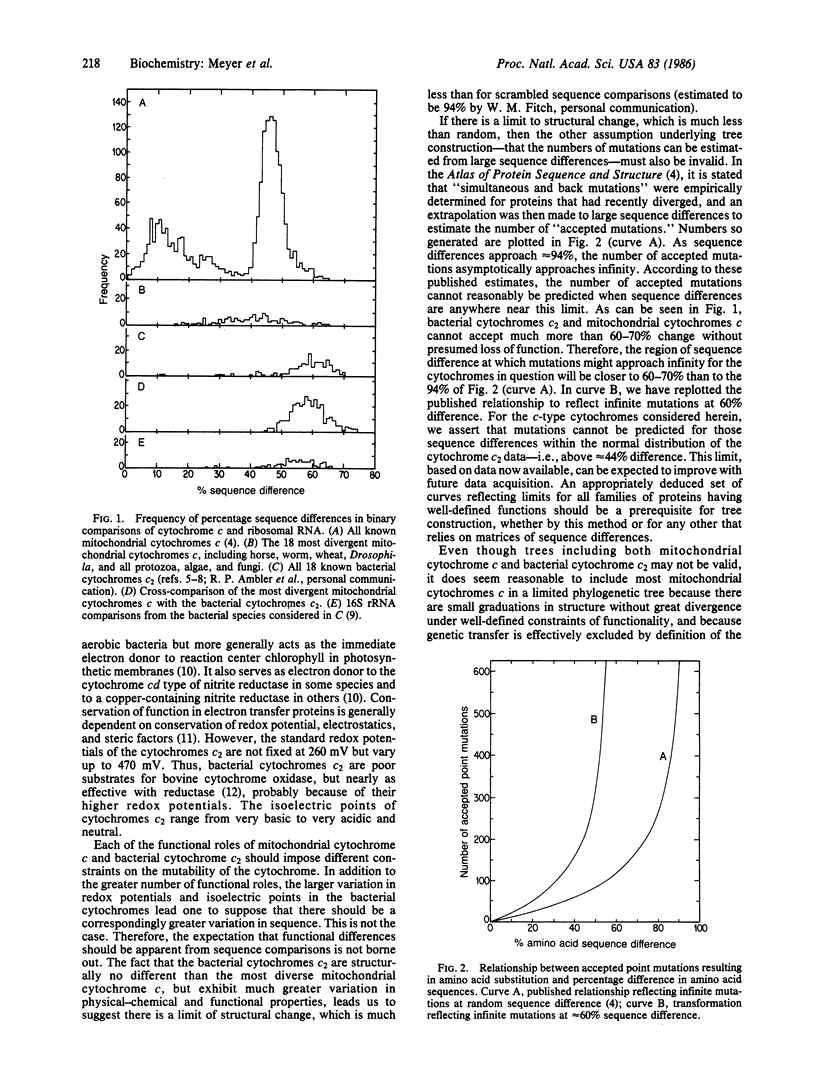Abstract
It has been proposed that phylogenetic trees, intended to show divergence of eukaryotic protein and nucleic acid sequences, be extended to include those from bacteria. However, we have compared the amino acid sequences of 18 of the most divergent mitochondrial cytochromes c with those of 18 bacterial cytochromes c2 and have found that the average percentage difference between these mitochondrial cytochromes c and cytochromes c2 was not significantly greater than that among the cytochromes c2 alone. The large discontinuities in physical-chemical properties recognized between the prokaryote and eukaryote cytochromes render it highly improbable that members of the two classes should be no more different from one another than members of either class alone, assuming that sequence differences can accurately reveal evolutionary divergence. Instead, we propose that divergent amino acid sequences approach a limit of change considerably less than for comparison of random sequences. This limit of change presumably is determined by the structure/function relationship. When two homologous protein sequences have reached such a limit, convergence or back-mutations and parallel mutations become as frequent as divergent mutations. As two diverging proteins approach this steady-state condition, sequence differences no longer reflect the numbers of mutations resulting in amino acid substitution and therefore species cannot be positioned on a phylogenetic tree. Insertions and deletions are less reversible than are amino acid substitutions and, provided they are well-documented, might be more reliable indicators of bacterial relationships. Nevertheless, we suggest that data available on bacterial protein sequences do not permit construction of all-inclusive phylogenetic trees. Comparisons of protein and rRNA trees suggest that similar restrictions apply to use of rRNA sequence data.
Full text
PDF



Selected References
These references are in PubMed. This may not be the complete list of references from this article.
- Ambler R. P., Bartsch R. G., Daniel M., Kamen M. D., McLellan L., Meyer T. E., Van Beeumen J. Amino acid sequences of bacterial cytochromes c' and c-556. Proc Natl Acad Sci U S A. 1981 Nov;78(11):6854–6857. doi: 10.1073/pnas.78.11.6854. [DOI] [PMC free article] [PubMed] [Google Scholar]
- Ambler R. P., Daniel M., Hermoso J., Meyer T. E., Bartsch R. G., Kamen M. D. Cytochrome c2 sequence variation among the recognised species of purple nonsulphur photosynthetic bacteria. Nature. 1979 Apr 12;278(5705):659–660. doi: 10.1038/278659a0. [DOI] [PubMed] [Google Scholar]
- Ambler R. P., Daniel M., Hermoso J., Meyer T. E., Bartsch R. G., Kamen M. D. Cytochrome c2 sequence variation among the recognised species of purple nonsulphur photosynthetic bacteria. Nature. 1979 Apr 12;278(5705):659–660. doi: 10.1038/278659a0. [DOI] [PubMed] [Google Scholar]
- Ambler R. P., Meyer T. E., Kamen M. D., Schichman S. A., Sawyer L. A reassessment of the structure of Paracoccus cytochrome c-550. J Mol Biol. 1981 Apr 5;147(2):351–356. doi: 10.1016/0022-2836(81)90445-9. [DOI] [PubMed] [Google Scholar]
- Errede B., Kamen M. D. Comparative kinetic studies of cytochromes c in reactions with mitochondrial cytochrome c oxidase and reductase. Biochemistry. 1978 Mar 21;17(6):1015–1027. doi: 10.1021/bi00599a012. [DOI] [PubMed] [Google Scholar]
- Fitch W. M., Margoliash E. Construction of phylogenetic trees. Science. 1967 Jan 20;155(3760):279–284. doi: 10.1126/science.155.3760.279. [DOI] [PubMed] [Google Scholar]
- Meyer T. E., Kamen M. D. New perspectives on c-type cytochromes. Adv Protein Chem. 1982;35:105–212. doi: 10.1016/s0065-3233(08)60469-6. [DOI] [PubMed] [Google Scholar]
- Tanaka Y., Fukumori Y., Yamanaka T. The complete amino acid sequence of Nitrobacter agilis cytochrome c-550. Biochim Biophys Acta. 1982 Sep 22;707(1):14–20. doi: 10.1016/0167-4838(82)90390-9. [DOI] [PubMed] [Google Scholar]
- Tedro S. M., Meyer T. E., Kamen M. D. Primary structure of a high potential, four-iron-sulfur ferredoxin from the photosynthetic bacterium Rhodospirillum tenue. J Biol Chem. 1979 Mar 10;254(5):1495–1500. [PubMed] [Google Scholar]
- Tollin G., Cheddar G., Watkins J. A., Meyer T. E., Cusanovich M. A. Electron transfer between flavodoxin semiquinone and c-type cytochromes: correlations between electrostatically corrected rate constants, redox potentials, and surface topologies. Biochemistry. 1984 Dec 18;23(26):6345–6349. doi: 10.1021/bi00321a009. [DOI] [PubMed] [Google Scholar]
- Wilson A. C., Carlson S. S., White T. J. Biochemical evolution. Annu Rev Biochem. 1977;46:573–639. doi: 10.1146/annurev.bi.46.070177.003041. [DOI] [PubMed] [Google Scholar]
- Woese C. R., Stackebrandt E., Weisburg W. G., Paster B. J., Madigan M. T., Fowler V. J., Hahn C. M., Blanz P., Gupta R., Nealson K. H. The phylogeny of purple bacteria: the alpha subdivision. Syst Appl Microbiol. 1984;5:315–326. doi: 10.1016/s0723-2020(84)80034-x. [DOI] [PubMed] [Google Scholar]
- Wu T. T., Fitch W. M., Margoliash E. The information content of protein amino acid sequences. Annu Rev Biochem. 1974;43(0):539–566. doi: 10.1146/annurev.bi.43.070174.002543. [DOI] [PubMed] [Google Scholar]


